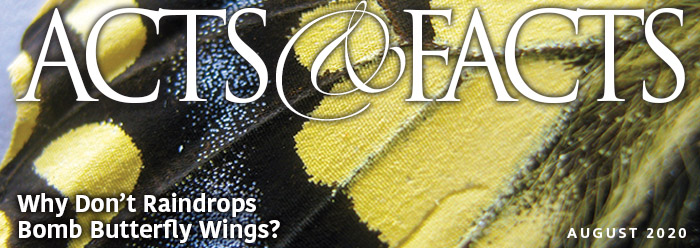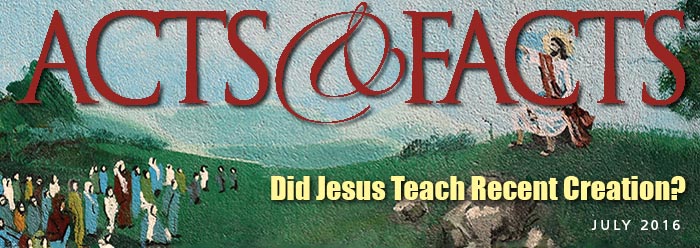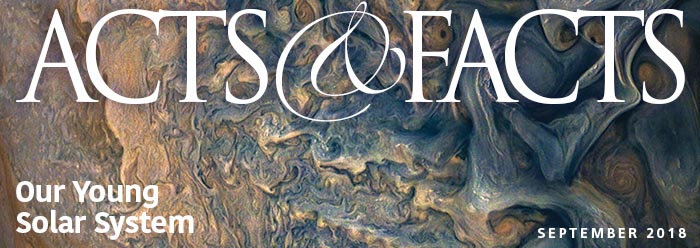 How do you tell the story of the universe? That’s a tall order, but I’ll give you a clue—it doesn’t start with a Big Bang somewhere in the outer reaches of space. The real account of our origins begins in Genesis with the Creator of the world.
How do you tell the story of the universe? That’s a tall order, but I’ll give you a clue—it doesn’t start with a Big Bang somewhere in the outer reaches of space. The real account of our origins begins in Genesis with the Creator of the world.
In our DVD series The Universe: A Journey Through God’s Grand Design—available this fall—a dedicated team of science and Bible experts discuss fascinating details of our divinely orchestrated universe. Markus Lloyd joins us again as host to guide us through the adventure. This is ICR’s fourth DVD series, and no matter the subject, we always return from the rigors of filming with great appreciation for the hard work that goes into this kind of production. We also bring back a few good stories.
Our filming journey began in Dallas studios on a set sprinkled with low-hanging Edison-style lightbulbs. Drs. Jake Hebert, Vernon Cupps, Jason Lisle, and James J. S. Johnson described scientific discoveries throughout history that impact what we know today about the universe. They discussed the work of Ptolemy, Copernicus, Kepler, and Galileo, and the development of telescopes and spectroscopes to help us explore the realms of the unknown.
Drs. Danny Faulkner and D. Russell Humphreys joined our crew near Houston at the George Observatory to talk about planets, stars, and magnetic fields. Dr. Don DeYoung met with us in Sugar Land, Texas, at the Houston Museum of Natural Science. And NASA astronaut Col. Jeffrey Williams graciously opened his home to us for a visit about space travel and NASA discoveries over the years.
For the first episode, Markus Lloyd guided us through the Mount Wilson Observatory in Angeles National Forest, California. We took a look at telescopes that are over a hundred years old—a 1914 36-inch telescope and a massive 1917 100-inch telescope (on the cover of this month’s Acts & Facts)—and checked out what they could reveal about planets, stars, and other celestial bodies.
We also filmed at the Anza-Borrego Desert so viewers can get a feel for the barren landscape of Mars. Our challenges there included wind and sand—lots of it. The unique environment provoked some odd questions: Do we really need to try to retrieve the screen that blew off the side of the sandy cliff? When do rattlesnakes come out of hiding? Should we steer clear of chuckwallas, too? How does being sandblasted by the desert wind compare to a spa facial? Okay, maybe the men on our team didn’t consider that last question.
We experienced some excitement on the beaches of Windansea and La Jolla. Helicopters, surfers, dogs, joggers, walkers, and waves delayed our filming and triggered countless retakes. Even sea lions wanted to get in on the action! During one day of particularly tight deadlines, we rolled up our pant legs and kept filming as waves sloshed against our calves in the rising tide. For one scene, we set up in a small cove surrounded by huge boulders when a sea lion washed in. The film director became trapped behind a rock with the frightened creature, and it chomped his knee, causing a deep gash. (Remember, this is a sea lion.) After a trip to an urgent care clinic, several stiches, and an antibiotics prescription, we set off on the next leg of our journey—the show must go on.
During episode two, Markus talked about how ancient mariners used stars to navigate ships on the seas. For this scene, we filmed him aboard the historic ship Elissa in the port of Galveston, Texas. It was a serious monologue until we discovered a slight, elderly gentleman dancing a jig behind our speaker in full view of the camera. (You can find the video of this jig-dancing photo-crasher on our Facebook page.)
We moved on to Huntsville, Alabama, the next day to tour the U.S. Space & Rocket Center and filmed shuttles, rockets, space capsules, simulators, and more. At the sprawling facility where over 1,500 space artifacts are on display, we caught a glimpse of the U.S. space program’s enormous achievements through the years. Filming stopped and started frequently because students taking part in the Space Camp moved into the camera’s view every few seconds. After filming all day and most of the evening, the director finally called “That’s a wrap!” and we began loading equipment. Famished, we were ready to find an open restaurant for a late-night dinner, but it came to our attention that one of the local crew members lost his keys somewhere during our day of filming. We retraced every step over the multi-acre campus to search for the keys. Unfortunately, we eventually had to leave without them.
A few days later in Waco, Texas, we filmed actors portraying Isaac Newton, Galileo Galilei, and Johannes Kepler. Our actors appeared in convincing period costumes, and props had been painstakingly prepared. We were ready to begin shooting until Newton picked up the quill pen. The actor was right-handed, but many scholars believe Newton was left-handed. It was the same case with Galileo. So, we went through some last minute left-handed training before we could film the scenes.
As we captured footage for The Universe series, a similar theme ran through every interview and every scripted scene: What we see on Earth and in the heavens beyond didn’t happen by chance. The universe displays majestic evidence that our omnipotent Creator put everything in place exactly as He planned. The history of astronomy reveals a foundation laid by scientists who believed the world was created by God. Their Christian worldview was not a hindrance to science but a help. The belief that God created the universe in a consistent and orderly way furthered their understanding of its nature and laws, just as it does for us today.
We are still putting the finishing touches on this DVD series and plan to release it this October. We can’t wait for you to see the vivid animations, breathtaking locations, and faith-building evidence we’re putting together for you. Amid the noise of Big Bang claims and naturalistic philosophy, our incredible universe shouts the glory and majesty of our Creator. We hope this series will leave you in awe of His heavenly handiwork!
* Jayme Durant is Director of Communications at the Institute for Creation Research.
















